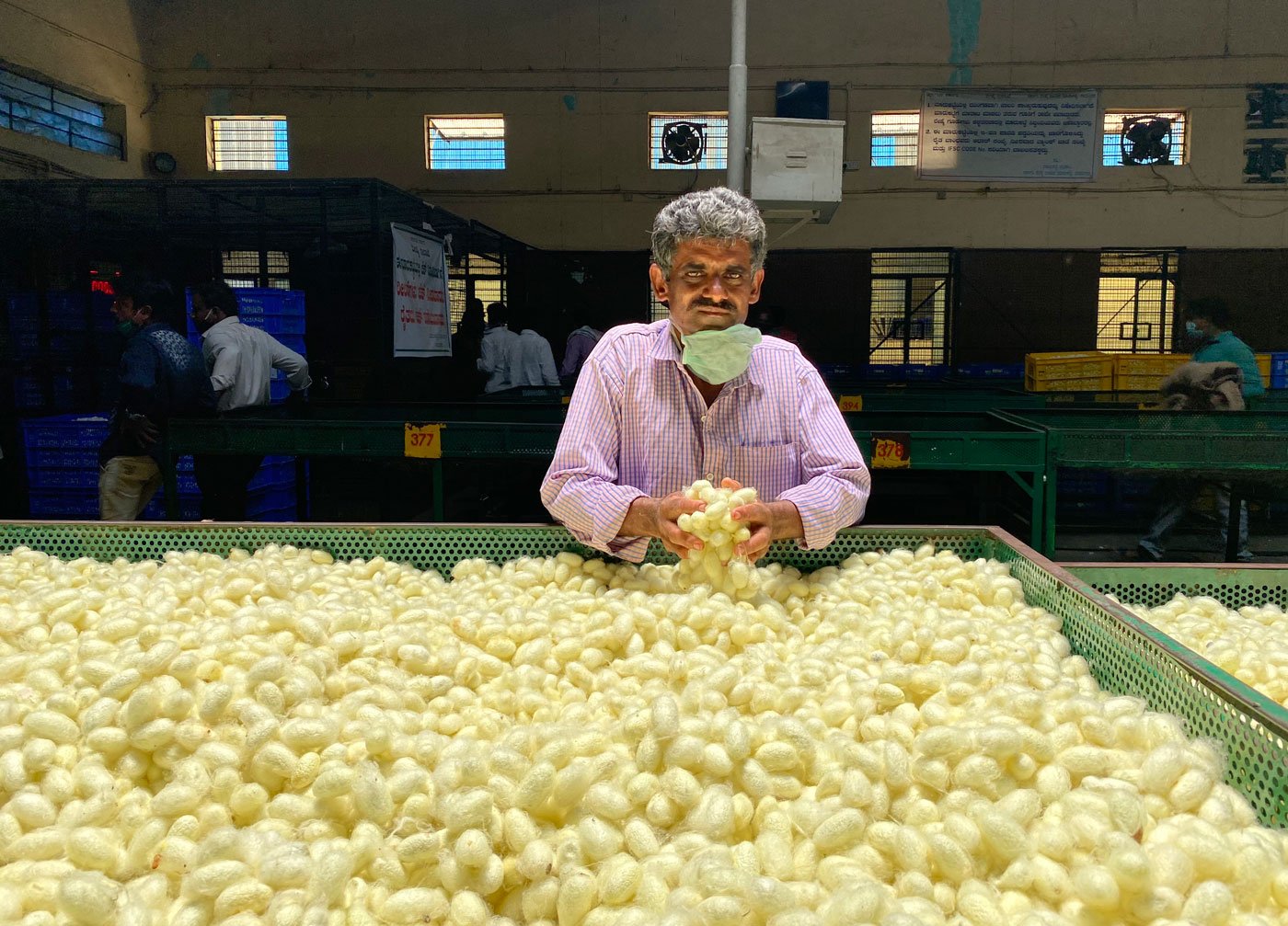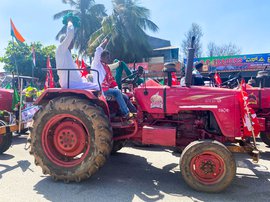When Nikhirappa Gadiyappa travelled through the night from Haveri taluk to the silk cocoon market in Ramanagara town at the end of May, he was hopeful of getting a decent price for his cocoons. But during the 11-hour non-stop 370-kilometre journey by tempo – with food stalls along the way closed due to the lockdown – he was fearful too. What if only a low price was offered for his cocoons?
On the return journey to Handiganur, his village in Haveri district, his hope was gone – and his fears had come true. He had sold his entire lot of 250 kilograms of bivoltine cocoons for just Rs. 67,500 – or Rs. 270 per kilo.
In early March, bivoltine cocoons could fetch around Rs. 550 a kilo, and cross-breed cocoons were sold on average at Rs. 480 per kilogram due to the high wedding-season demand. In other seasons of normal demand, the average price of bivoltine silk cocoons is Rs. 450-500 a kilo, and crossbreed silk cocoons fetch Rs. 380-420. (Bivoltine is white superior quality cocoons; cross-breed varieties are yellowish and developed by combining hardier low quality and bivoltine strains.)
“I started growing mulberry [in 2014] on my ancestral land for producing cocoons. Now, we are forced to sell them at throwaway prices. I don’t know how I will repay my unpaid loans,” says 42-year-old Gadiyappa.
Until 2014, Gadiyappa had worked as an agricultural labourer in the fields of Karnataka’s Haveri district for a daily wage of Rs. 150-170. On their own three-acre land, his 10-member family cultivated mainly jowar and groundnut – for their own consumption as well as for the market. In 2016, Gadiyappa took five more acres on lease for some of the jowar and groundnut, while mulberry took up the rest of the acreage – a decision he hoped would help him earn some more.
Gadiyyapa and other farmers sell the cocoons roughly once every 35-45 days – or around 10 times a year. It takes around 23 day for
chawki
(small silkworms)
to form cocoons. For this round, Gadiyappa had started rearing the worms in the first week of May. He spent around 10 hours every day to tend to the cocoons, ensuring they were not infected or impacted by the humid weather. Then came the trip to the Ramanagara market at the end of May – and the loss he has shouldered.
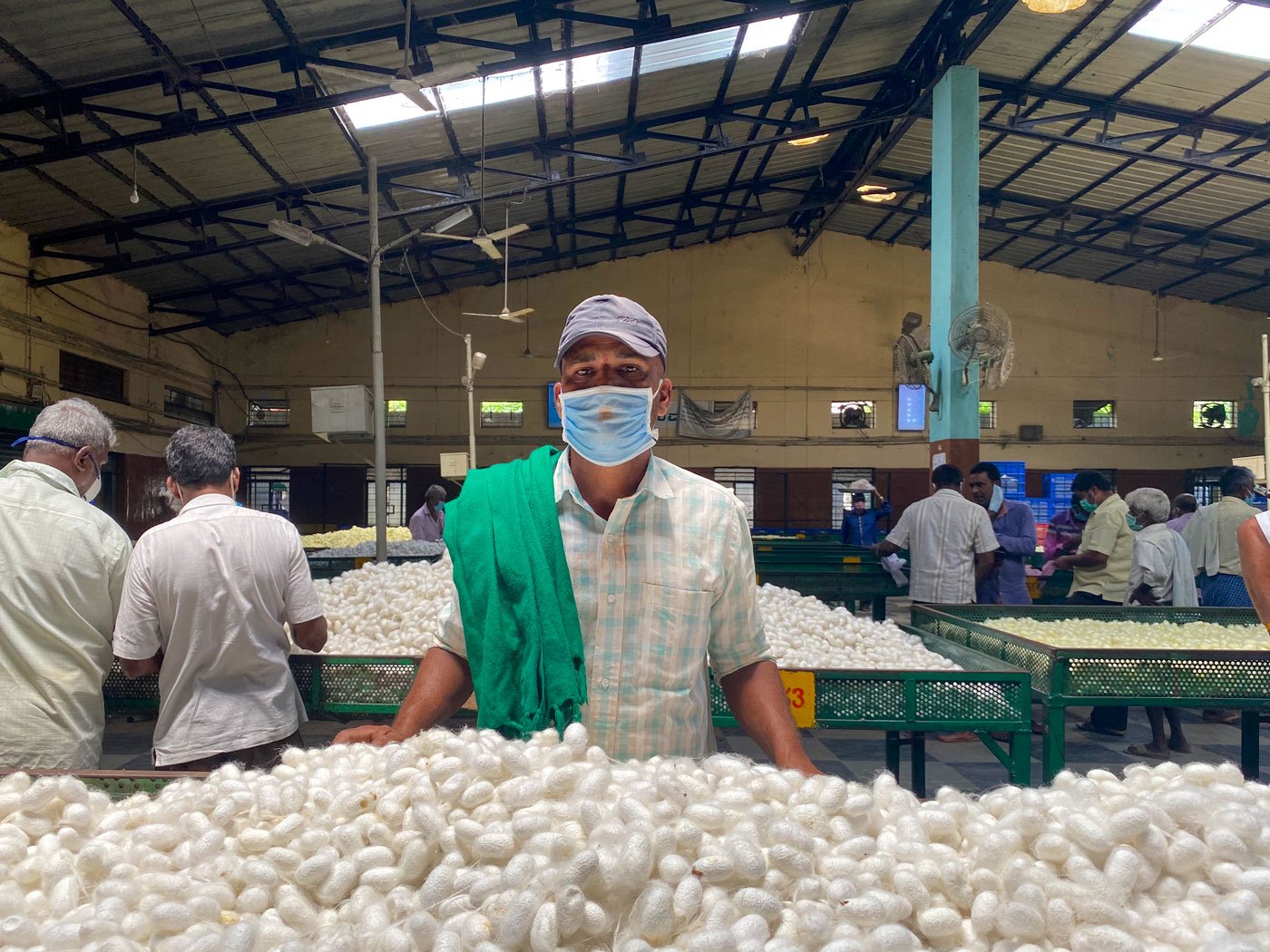
On the return journey to Handiganur village, silk cocoon farmer Nikhirappa Gadiyappa's hope was gone – and his fears had come true
“I barely made a profit of Rs. 20,000 after spending around Rs. 48,000 on labour,
chawki
, fertilisers, maintenance and transportation,” a worried Gadiyappa says. His creased forehead, with a faint stroke of vermillion, underlines his worry.
The Covid-19 lockdown has hit the silk industry hard, crushing the hopes of many farmers like Gadiyappa who come to the Government Cocoon Market in Ramanagara – the largest such market in Asia . Here, says the market’s deputy director, Munshi Basaiah, on average 35-40 metric tonnes of cocoon are sold daily. Karnataka contributed 32 per cent of the 35,261 metric tonnes of silk India produced in 2018-19. (The country is the second largest producer of silk in the world after China).
In the sprawling market in Ramanagara – a town with a population of around 1.1 million people – there are huge halls with large metal trays filled with cocoons brought by farmers from across Karnataka. The market remains open 24 hours as many farmers reach here at night for the next day's auction process.
During business hours, hundreds of silk reelers, most of them from Karnataka, inspect the cocoons and bid on them through an e-auction process. The reelers are the main buyers – they produce raw silk from cocoons by using devices like charkhas and automatic reeling machines, and then sell the silk to weavers.
After the day’s e-auction, farmers collect the transaction bills from the cash counter. But prices at the Ramanagara market have been on a free fall since March. If they are lucky, on some days the farmers are earning a small profit, but on most days they are incurring huge losses.
Chandrashekhar Siddalingaia from Doddaballapur taluk glances at his bill in disbelief. He has sold 166 kilograms of cocoon for Rs. 320 per kilo. “I spent Rs 130,000 for producing these,” he says. “My brother bought superior quality eggs to ensure we get good cocoons.” This meant higher production costs too for the brothers, who rear cocoons on four acres of land. “There aren’t any buyers, we were forced to sell at a very low price. This is a huge loss for farmers like us,” Siddalingaia says.
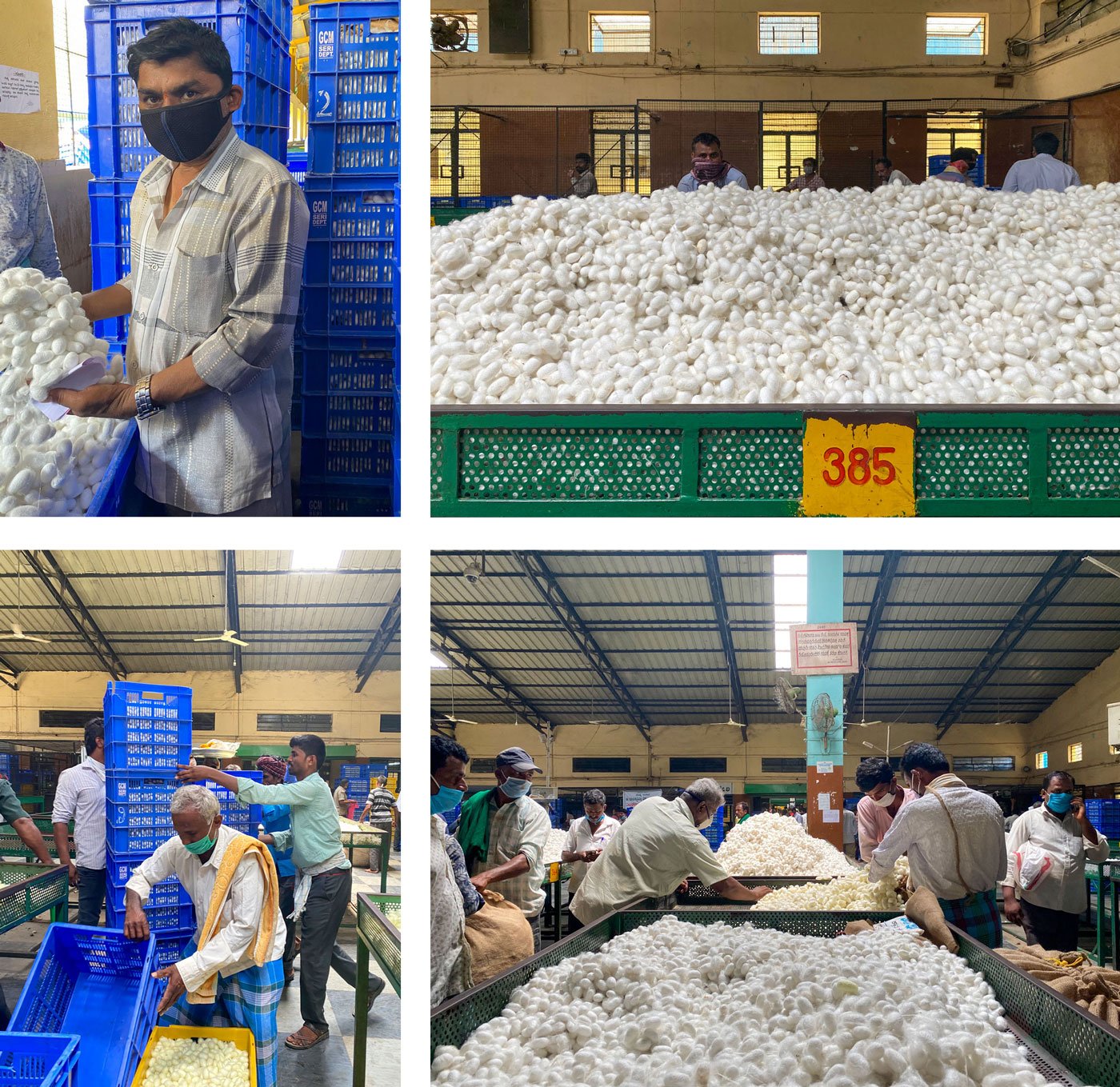
Top left: Chandrashekhar Siddalingaia was stunned by the the low prices. 'Look, my cocoons are good', he says, at the Government Cocoon Market in Ramanagara – Asia's largest such market. Heaps of cocoons are kept in plastic and metal trays, and reelers-traders bid on them in an e-auction
“We reached here the previous night. We didn’t even have food properly, most of the tea stalls near the silk market are shut too,” the 50-year-old farmer adds, visibly fatigued. Still, he travelled 90 kilometres to sell his cocoons in Ramanagara, because he says, “In my village or local markets they [silk reelers] offer just Rs. 200 a kilo. For how long will farmers like me survive like this?”
As Siddalingaiah begins his walk back to the counter at the market, his sold cocoons are loaded in plastic crates by labourers. He picks up a handful: “Look, my cocoons are good. This is the best quality product. I sold the same stuff for Rs. 600 in December.” Siddalingaia’s family of six depends entirely on the earnings from silk cocoons. “My wife and brother work with me on the fields. We have employed five labourers as well. All our hard work is wasted,” he adds.
One of the reasons for the fall in prices is the disruption of the entire demand-supply chain. Many marriages have been postponed, events stand cancelled, and apparel stores are mostly shuttered – so the demand for silk has sharply decreased, which in turn has kept silk reelers away from Ramanagara, say market officials and others.
But while reelers and weavers might at least have the option of stocking silk, the farmers can’t afford to wait – they have to sell the perishable cocoons on time.
The process of making silk starts with the mating of domesticated silkworm moths. The eggs they lay are then hatched in silkworm rearing units. Next, eight-day-old silkworms are sold to farmers for producing the cocoons. Farmers either visit chawki centres or purchase through agents – they buy 75,000-90,000 small worms for around Rs. 1,800-5,000, depending on the type, for each 23-day cocoon-production cycle. (For each purchase of bivoltine silkworms, the government gives the farmers Rs. 1000 as a subsidy.)
The farmers feed the worms mulberry leaves at regular intervals, maintain adequate temperature (24-28 degrees Celsius) and relative humidity (65-75 per cent) with sprinklers and humidifiers in specially built rearing houses. This ensures that the worms, placed in bamboo trays and covered with newspapers, remain disease-free for 20-23 days. The cocoons they then produce are sold in the market to the reelers, who extract silk and sell it to weavers and traders. To build silkworm rearing houses, farmers need to invest money (many take loans) to buy humidifiers, sprinklers, bamboo trays and other equipment.
The
chawki
rearing centres were temporarily shut too for a week from March 25, when the lockdown began. Many of the centres reduced production and discarded the small worms and eggs. But since silkworm rearing is time-bound, production resumed and farmers could continue to buy silkworms from the rearing centres during the lockdown.
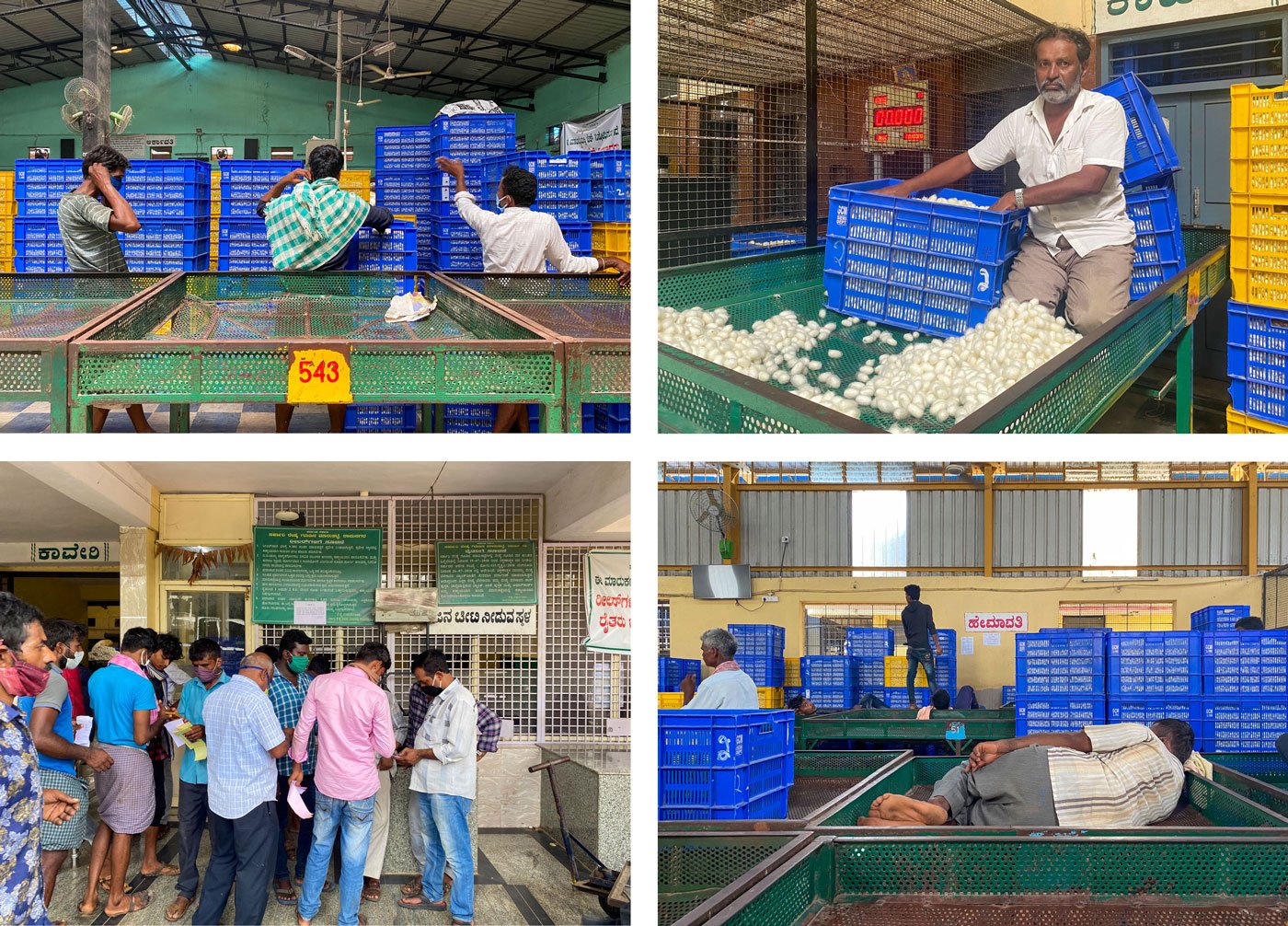
The Covid-19 lockdown hit the silk industry hard, crushing the hopes of many cocoon farmers like Puttrama Dalagowda, who come to this market in Ramanagara from Harisandra village in Ramanagara taluk . Bottom left: Silk cocoon farmers queue up outside the counter for receipts. Bottom right: Resting after a hard day on May 27, 2020
For the first time after Independence, officials say, the Ramanagara market too remained shut for a week from March 25 to April 1. After it re-opened, the average price of bivoltine silk dropped to Rs. 330 per kilogram, and of cross-breed silk cocoons to Rs. 310 per kilo. In the past, the silk market in Ramanagara usually remained shut only for two days — on Republic Day and Independence Day — in the entire year.
When the lockdown restrictions were slowly relaxed across the country, silk cocoon farmers were expecting the rates to bounce back. Prices, however, spiralled further down. By the last week of May, the average price of bivoltine cocoon was below Rs. 250 and crossbreed cocoons were sold for roughly Rs. 200.
“Silk reelers in Karnataka sell silk to weavers and traders across the country, but However, their primary market is Tamil Nadu and Andhra Pradesh,” says deputy director Munshi Basaiah. “But when the lockdown began, transportation was not allowed. So now the reelers have silk in excess and there’s no demand from their side.”
Mahendra Kumar G. M., deputy director, Department of Sericulture, Ramanagara, explains, “Before the Covid-19 pandemic scare, 850-900 reelers visited and took part in the auction in the silk market daily. After the market was reopened on April 2, 450-500 buyers still visited the market. By the end of May, only 250-300 reelers bought silk cocoons. Meanwhile, the number of farmers dropped only in the first few days in April. Otherwise, this number didn’t vary much.”
In addition to the “supply-demand factor” for the low prices, Kumar adds, “There are other reasons as well. Silk reelers aren’t left with much capital to buy cocoons. The quality of cocoons sold in the market is bad; only five per cent cocoons are good. Moisture isn’t good for cocoons. During the rains [it’s been raining in south Karnataka, lowering temperatures], the production quality deteriorates. That’s why only very few reelers are buying silk cocoons in the market now.”
It is difficult to ascertain when farmers will start getting better prices, note officials in the sericulture department.
Amid this uncertainty, for many cocoon farmers, sustaining their expenses is a big challenge. So Boralingaiah Boregowda and Ramakrishna Boregowda are destroying their mulberry trees spread across four acres of land in Ankushanahalli village in
Channapattana
taluk
of Ramanagara district. They have now vowed to stay away from producing cocoons till prices don’t stabilise.
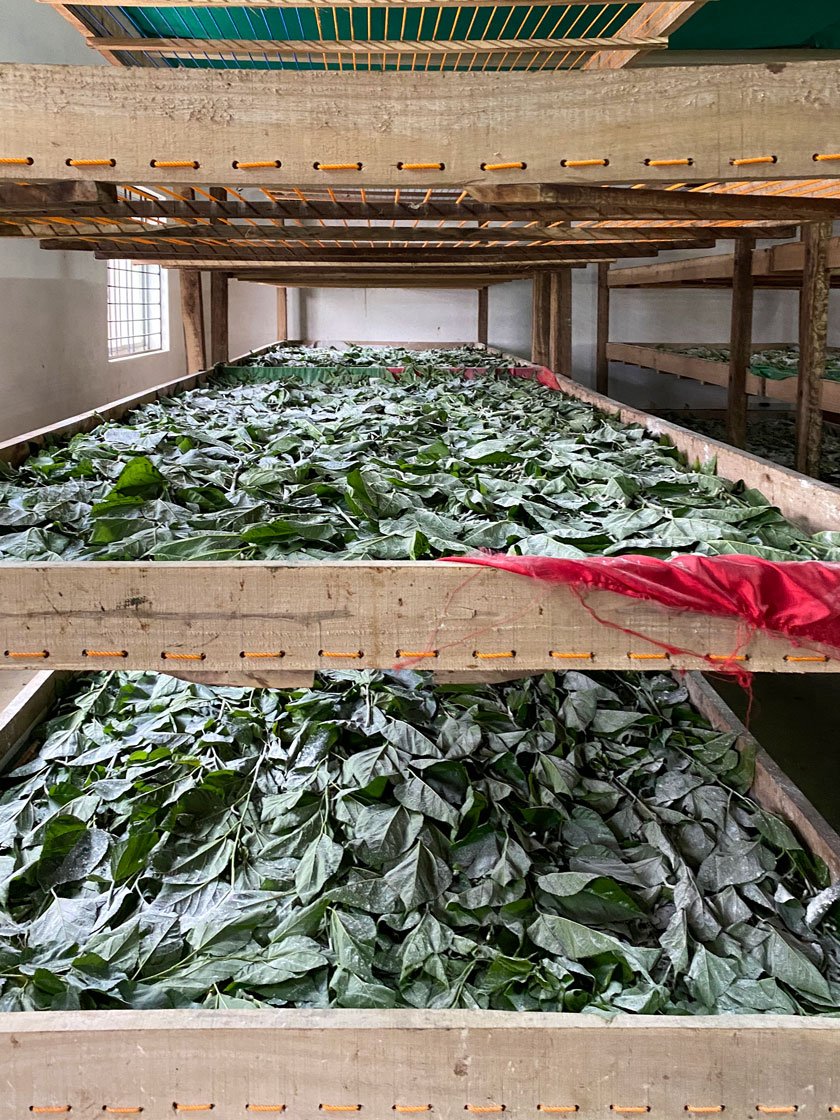
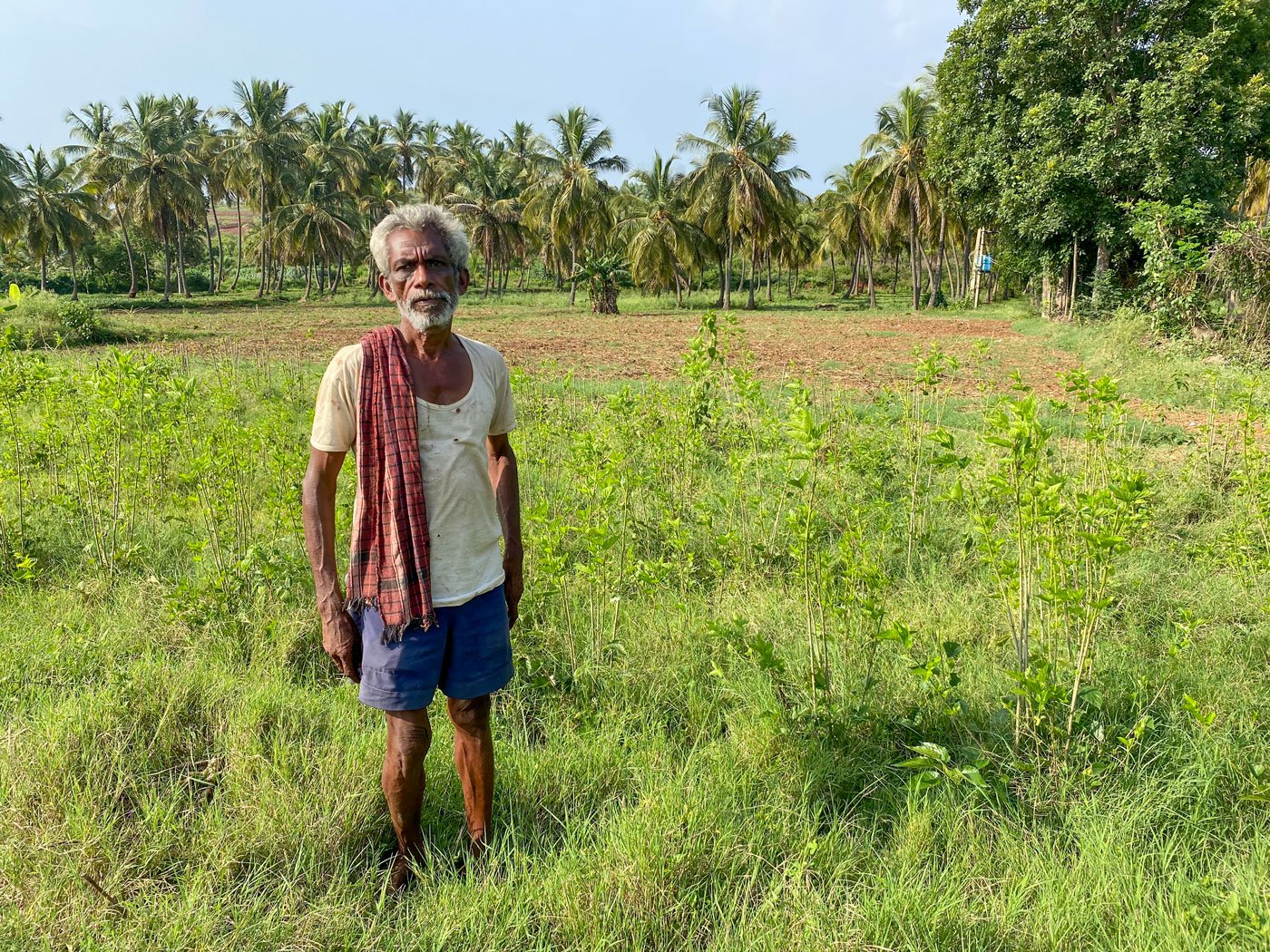
The mulberry leaves (left) fed to silkworms in cocoon farmer Ramakrishna Boregowda's rearing unit in Ankushanahalli village. With severe losses this year, he has started removing the mulberry crop from his land and plans to stop producing cocoons
“All these years we made adjustments,” says 60-year-old Ramakrishna. “Sometimes we sold bananas and tomatoes to raise money for cocoon production. At times, we sold cocoons to maintain other cultivation. Now, we are not able to sell anything in the market. Tomatoes and bananas are rotting on the fields. Nobody wants to even buy our coconuts. I have struggled all my life. But something kept us going always. There’s nothing left for us to sell now.”
Boralingaiah and Ramakrishna are brothers who jointly own 20 acres of land. Over the years, they have taken three bank loans amounting to Rs. 17 lakhs for their farming expenses. The loans remain unpaid. Two silkworm-rearing units they built three years ago cost Rs. 8 lakhs; the state government gave them Rs. 1 lakh as subsidy. Now, worms are kept in only one of these units. “After cocoons are produced from this batch, we will stop operations. What is the point of working so hard, using sprinklers, bearing electricity costs and paying labourers if we don’t get the money back from the market? We don’t have the means to keep cocoon work going further,” Ramakrishna says.
Half of their mulberry fields are yet to be cleared. “We will feed the remaining leaves to our cows. After clearing the field, we will plant coconuts. Maybe we will make some money by selling coconuts,” 70-year-old Boralingaiah says, smiling toothlessly. The family is managing with rations procured on their BPL card, and with the ragi and vegetable they cultivate on some patches of their land.
Moving away from silk cocoon production, however, is not a viable option for many other farmers involved in the silk industry. Some are forced to continue producing cocoons because they don’t grow other crops that can sustain them temporarily.
“I cannot stop work even for a day just because the prices are low. How will I feed my family?” asks Gadiyappa.To produce the next batch of cocoons, he will now have to borrow more money. He already has two unpaid loans – Rs. 3.5 lakh from a cooperative bank at an interest of 12 per cent in 2019, and a crop loan of Rs 1.5 lakh at an interest of 7 per cent from Vijaya Bank taken four years ago. He is yet to pay the principal amount of both loans.
“I won’t be able to manage running costs without another loan now. But no one is willing to give money,” Gadiyappa adds. “Even if I earn Rs 10,000 [per cocoon production cycle] at least we can manage a meal. Otherwise my family will die hungry. I know it is difficult. But I will find a way. Once corona goes away, things will be normal.”
Cover photo: M.S. Rudra Kumara, cocoon farmer from Marasinganahalli village in Maddur taluk of Mandya district.
